Pendergast T., Pendergast S. St. James Encyclopedia of Popular Culture. Volume 1: A-D
Подождите немного. Документ загружается.

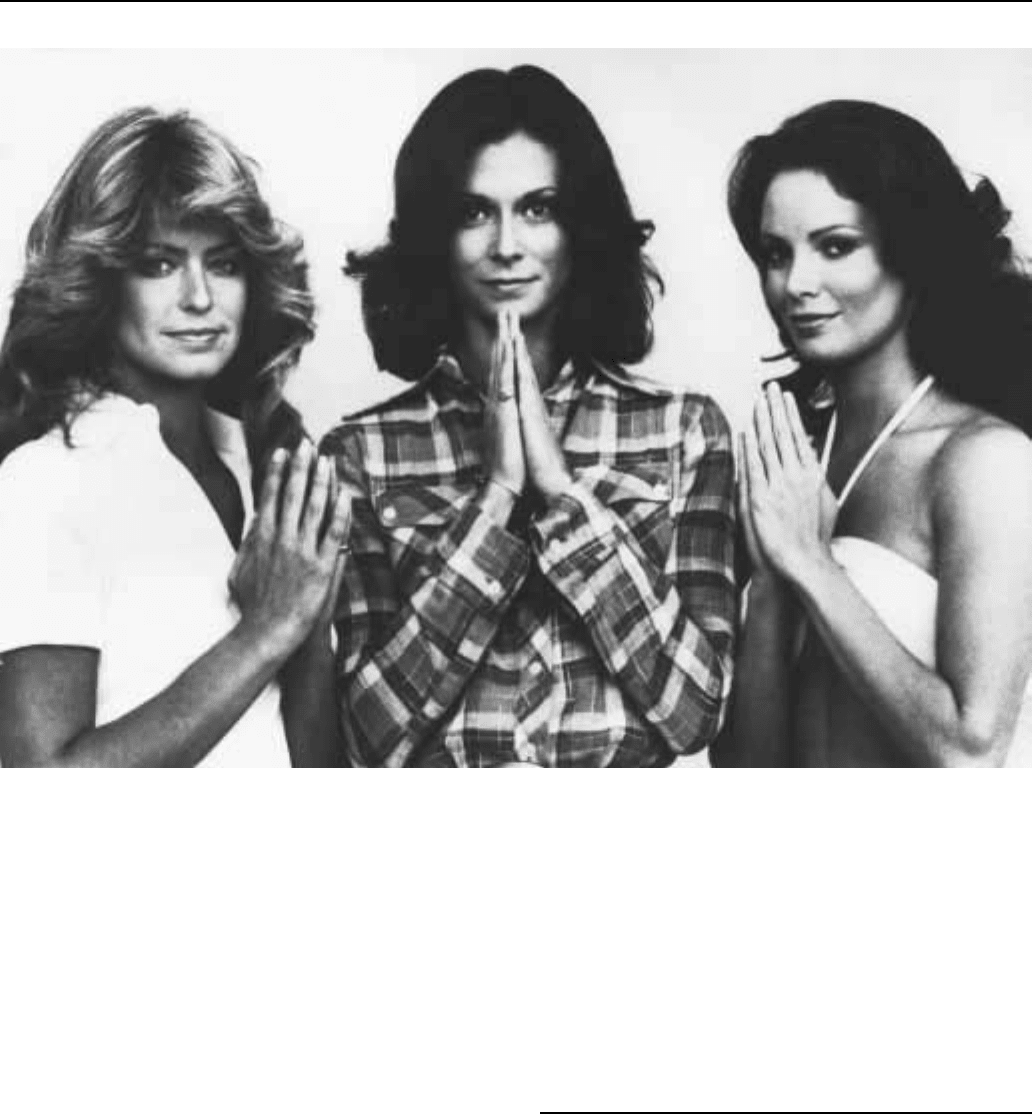
CHARLIE’S ANGELSENCYCLOPEDIA OF POPULAR CULTURE
479
Charlie’s Angels: (from left) Farrah Fawcett-Majors, Kate Jackson, and Jaclyn Smith.
As Jim Harmon has pointed out in The Great Radio Comedians,
‘‘The humor (of Bergen and McCarthy) sprang from (an) inevitable
misunderstanding between a rather scholarly man and a high-school
near-dropout with native wit and precocious romantic interests. What
resulted was wildly comic verbal fencing, perfect for the sound-
oriented medium.... Exasperating to some adults, but we who were
children at the time loved it.’’ Not unlike Groucho Marx, Charlie
appealed to listeners of all ages because he could get away with saying
something naughty or insulting to parental and authority figures. With
such catch phrases as ‘‘Blow me down!,’’ Charlie endeared himself to
generations of listeners and viewers, and paved the way for many
successful ventriloquism acts that followed. Bergen’s skill as a
comedy writer was such that he purposefully let Charlie have all the
laughs. When asked once whether he ever felt any hostility toward
Charlie, Bergen replied, ‘‘Only when he says something I don’t
expect him to say.’’
In 1978, ten days after announcing his retirement, Edgar Bergen
died. In his will, the ventriloquist had donated Charlie to the Smithso-
nian. In addition to the memory of decades of laughter, Bergen also
bequeathed to the world of show business his daughter, actress/writer/
photographer Candice Bergen.
—Preston Neal Jones
F
URTHER READING:
Bergen, Candice. Knock Wood. Boston, G. K. Hall, 1984.
Bergen, Edgar. How to Become a Ventriloquist. New York, Grosset &
Dunlap, 1938.
Harmon, Jim. The Great Radio Comedians. Garden City, N.Y.,
Doubleday, 1970.
Charlie’s Angels
Despite its pretensions as a prime-time detective show featuring
three women as ‘‘private eyes,’’ Charlie’s Angels was primarily
about glamour and bare skin. This proved to be a winning combina-
tion for the ABC network from 1976 to 1981 when the show broke
into the top ten of the Nielson ratings in its first week and improved its
position with each subsequent airing. While this success was due, in
no small part, to the machinations of ABC’s programming genius
Fred Silverman, who put it up against two short-lived, male dominat-
ed adventure shows—Blue Knight and Quest—one cannot discount
the appeal of three pretty women to viewers of both sexes.

CHARM BRACELETS ENCYCLOPEDIA OF POPULAR CULTURE
480
Yet, the program’s concessions to its female audience were slim.
Beyond the symbolic breakthrough of having three women perform-
ing in roles normally reserved for men, while paying attention to
fashions and hairstyles, most of the show was dedicated to keeping
male viewers in a state of titillation and expectation. While likening
Charlie to little more than a glorified ‘‘pimp,’’ feminist journalist
Judith Coburn commented in a 1976 article that Charlie’s Angels was
one of the most ‘‘misogynist’’ shows that the networks had ever
produced. ‘‘Supposedly about strong women, it perpetuates the
myth most damaging to women’s struggle to gain professional
equality: that women always use sex to get what they want, even on
the job.’’
Generally, the plots revolved around the three sexy female
detectives who have left the police department to work for an unseen
boss named Charlie (John Forsythe) who conveyed his assignments
by telephone and through an assistant named John Bosley (David
Doyle). Each weekly episode usually called for one of the three
women to appear in a bikini or shorts within the first few minutes of
the show to hook the male viewers. After that, most of the stories
would be set in exotic locations such as Las Vegas, Palm Springs, or
other areas within easy reach of Los Angeles to provide ample
opportunities for the ‘‘Angels’’ to strip down to bare essentials while
ostensibly staying within the confines of the shows’ minimal plots.
Yet, ironically, all of the sex was in the dialogue. While viewers
reveled in the sight of three gorgeous women in a variety of scanty
attire, they never saw them in bed. This might detract from their status
as consummate professionals in the detective business. According to
the show’s publicity, the angels were more than simply pretty faces,
sexy tummies, and cascading hair, they were martial arts experts, race
car drivers, and shrewd poker players. Of the initial cast, Sabrina
(Kate Jackson), was the multilingual, intellectual type; Jill Munroe
(Farrah Fawcett-Majors) the physical, action-oriented member, and
Kelly Garrett (Jaclyn Smith), the former showgirl, was the cool
experienced ‘‘been around’’ member of the team who provided calm
leadership under pressure.
The idea for the show originated with producers Aaron Spelling
and Leonard Goldberg, who had previously specialized in action
adventure shows normally dominated by the gritty realism of the
inner city. But these were dominated by male policemen and private
detectives. In an effort to compete with an upsurge of female
dominated action series such as Police Woman, The Bionic Woman,
andWonder Woman, Spelling and Goldberg decided to inject the
traditional private detective genre with a dose of feminine pulchritude
with three gorgeous women who not only solved crimes but looked
great doing it.
Although the show was initially intended to feature Kate Jack-
son, then the best known actress of the three, it was Farrah Fawcett-
Majors who became the most recognizable icon. Due to some
‘‘cheesecake’’ publicity photos, including a swimsuit poster that
quickly appeared on the bedroom walls of every thirteen-year-old boy
in America, and a mane of cascading blonde hair, Farrah quickly
became a fad, appearing on T-shirts and on toy shelves as Farrah dolls
swept the nation. She became caught up in the publicity and left the
show after the first season in hopes of capitalizing on her fame and
becoming a movie star. Spelling and Goldberg replaced her in 1977
with Cheryl Ladd as her younger sister Kris Munroe and the show
continued unimpeded.
—Sandra Garcia-Myers
F
URTHER READING:
Hano, Arnold. ‘‘They’re Not Always Perfect Angels.’’ TV Guide.
December 29, 1979, 19-23.
O’Hallaren, Bill. ‘‘Stop the Chase—It’s Time for My Comb-Out.’’
TV Guide. September 25, 1976, 25-30.
‘‘TV’s Superwomen.’’ Time. November 22, 1976, 67-71.
Charm Bracelets
While charms and amulets, trinkets and tokens to ward off evil,
were worn on the body in ancient Egyptian civilization and virtually
every other early culture, the twentieth-century charm is far removed
from such apotropaic forms. Rather, modern charms are often signs of
travel, place, and popular culture, suggesting sentiment and affinity
more than prophylaxis. Their peak came in the 1930s when silver or
base-metal charms could be accumulated over time and in hard times
constituted affordable jewelry. Bakelite and other new materials
could also make charms even less expensively. By the 1950s, charm
bracelets were chiefly associated with high-school girls and the
prospect of being able in high-school’s four years to fill all the links of
a bracelet with personal mementos. A 1985 fad for the plastic charm
bracelets of babies—letter blocks and toys—worn by adults for
infantilizing effect lasted less than a year.
—Richard Martin
F
URTHER READING:
Congram, Marjorie. Charms to Collect, Martinsville, New Jersey,
Dockwra Press, 1988.
Chase, Chevy (1943—)
Comedian, writer, and actor Chevy Chase met instant critical
success and stardom on Saturday Night Live(SNL), first coming to
public attention as the anchor of the show’s ‘‘Weekend Update’’
news spoof with his resounding ‘‘Good evening. I’m Chevy Chase,
and you’re not!’’ His mastery of the pratfall, deadpan outrage, and
upper-class demeanor made him a standout from the rest of the SNL
cast, and only a year later, Chase was Hollywood-bound and starring
in movies that capitalized on his SNL persona. Chase appeared as a
guest host of SNL in February 1978, and the show received the
highest ratings in its history.
Born Cornelius Crane Chase (his paternal grandmother gave him
the nickname Chevy) on October 8, 1943, in New York City, Chase
earned a bachelor’s degree from Bard College in 1967. He worked on
a series of low-level projects, developing his talents as a comedy
performer and writer. In 1973 he appeared in the off-Broadway
National Lampoon’s Lemmings, a satire of the Woodstock festival, in
which he portrayed a rabid motorcycle gang member and a John
Denver type singing about a family freezing to death in the Rockies.
In 1974 he wrote and performed for National Lampoon’s White
House Tapes and the National Lampoon Radio Hour. Chase went to
Hollywood in 1975, where he wrote for Alan King (receiving the
Writers Guild of America Award for a network special) and The
Smothers Brothers television series.
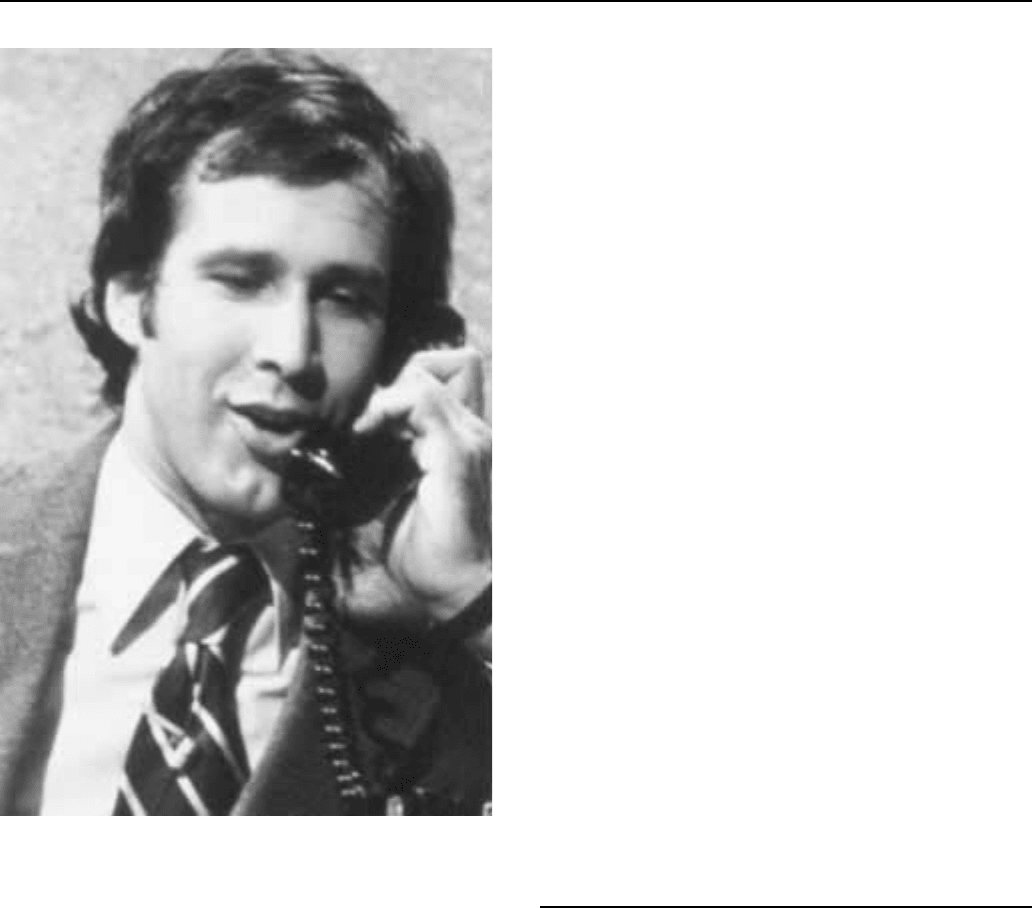
CHAUTAUQUA INSTITUTIONENCYCLOPEDIA OF POPULAR CULTURE
481
Chevy Chase on Saturday Night Live.
While in a line for movie tickets, Chase met future SNL producer
Lorne Michaels, who was so entertained by Chase’s humor that he
offered him a job writing for the new show, which debuted October
18, 1975. In addition to writing, however, Chase moved in front of the
camera, sometimes with material he had written for ‘‘Weekend
Update’’ just minutes before. Besides this role, he most famously
appeared as President Gerald Ford. His impersonation focused on
pratfalls, and served to create an image of a clumsy Ford, which the
president himself enjoyed: Ford appeared in taped segments of one
episode of SNL declaring ‘‘I’m Gerald Ford, and you’re not.’’ Chase
won two Emmys—one for writing and one for performing—for his
SNL work, but his standout success on a show that was supposed to
rely on a repertory of actors led to strained relations with the equally
popular John Belushi, Michaels, and other colleagues, especially
since Chase was not being paid as a performer but as a writer. Chase
left SNL in October 1976 and, tempted by movie offers, moved back
to California.
In 1978, Chase’s first major movie, Foul Play, received mixed
reviews, but his name was enough to ensure that it was profitable. The
movies that followed, including Caddyshack and Oh Heavenly Dog
(both in 1980) also made some money, but Chase himself made
negative comments about their artistic quality. In 1983, returning to
his comedy roots, Chase starred as Clark Griswold, a role perfectly
suited to his deadpan humor, in National Lampoon’s Vacation. The
movie was a great success and has since been followed by three sequels.
About this time, the actor also was coping with substance-abuse
problems. Like many other early alumni of SNL, he was exposed to
drugs early in his career, but he also had become addicted to
painkillers for a degenerative-disk disease that had been triggered by
his comic falls. He was able to wean himself from drugs through the
Betty Ford clinic in the late 1980s. In the meantime, he continued to
star in movies such as Fletch (1985).
His career began to flag at the start of the 1990s. Chase was heard
to remark that he missed the danger of live television, so it came as no
surprise to those that knew him that he took a major risk in launching
The Chevy Chase Show, a late-night talk show which was one of
several efforts by comedians in 1993 to fill the void left by the
retirement of Johnny Carson. Like many of the others, it was soon
canceled. Since then, Chase has made a number of attempts to revive
his movie career. He made the fourth Vacation movie (Vegas Vaca-
tion) in 1997 and began work on a new Fletch movie in 1999. Many
critics, however, see him as just going through the motions, cashing in
on his name and characters before it is too late. The public, however,
still thinks of him as Chevy Chase, man of many falls and
few competitors.
—John J. Doherty
F
URTHER READING:
‘‘Chase, Chevy.’’ Current Biography Yearbook. Edited by Charles
Moritz. New York, H. W. Wilson Co., 1979.
Hill, Doug, and Jeff Weingrad. Saturday Night: A Backstage History
of Saturday Night Live. New York, Beech Tree, 1986.
Murphy, Mary. ‘‘He’s Chevy Chase and They’re Not.’’ TV Guide.
August 28-September 3, 1993, 14-17.
The Chautauqua Institution
During its first eighty years, more famous men and women,
including American presidents, appeared under the auspices of the
Chautauqua Institution, located on the shore of Lake Chautauqua in
an obscure part of northwestern New York, than at any other place in
the country. Built in 1874, Chautauqua was headquarters for a
phenomenally successful late nineteenth-century religious and mass
education movement that satisfied a deep hunger throughout America
for culture and ‘‘innocent entertainment’’ at reduced prices.
Philosopher William James visited the site in 1899 and was
astonished by the degree to which its small-town values informed
nationwide programs. The institution reflected the inexhaustible
energies and interests of two founders, Lewis Miller, a wealthy
Akron, Ohio, manufacturer of farm machinery (and Thomas A.
Edison’s future father-in-law), and John Heyl Vincent, who at eight-
een had been licensed in Pennsylvania as a Methodist ‘‘exhorter and
preacher.’’ Both had grown up in rural America, and both were
especially knowledgeable about the tastes and yearnings of their
fellow citizens.
Long before James’s visit, Miller had helped finance revival
meetings in a hamlet near Lake Chautauqua, but attendance had

CHAVEZ ENCYCLOPEDIA OF POPULAR CULTURE
482
declined. While searching for a way to continue his vision of the
Lord’s work, Miller read some of Vincent’s writings, came to the
belief that financial salvation was attainable if some new purpose for
the site could be found, and contacted Vincent. Vincent disliked
razzle-dazzle evangelism but agreed that training young men and
women as Sunday school teachers could be the worthy purpose that
Miller sought.
A Sunday School Assembly was formed and enjoyed immediate
success. However, a looming problem was that as the school’s
enrollment steadily increased, so did concerns about chaperoning
students. Miller and Vincent feared possible scandals in sylvan
glades, unless idle time could be filled with regular and wholesome
educational and entertainment programs. To direct such activities,
they engaged William Rainey Harper, an Ohio-born educator, who
would later be John D. Rockefeller’s choice to serve as president of
the University of Chicago.
Like Miller and Vincent, Harper never opposed an idea because
it was new or unproven. Four years after the Sunday School Assembly
began operations the Chautauqua Literary Scientific Circle came into
being. One measure of its success was that within twenty years, ten
thousand reading circles, all of which took their lead from the
institution’s example, were operating throughout America. One fourth
were in villages of fewer than five hundred people, and Chautauqua
served them diligently, providing reading lists and other materials.
But innovations at Chautauqua did not stop with the training of
Sunday school teachers and reading circles. As early as 1883, it
chartered itself as a university and would remain one for twelve years,
until established universities began to offer summer courses. Some
three hundred ‘‘independent’’ or loosely affiliated similar institutions
used Chautauqua as a model without charge by the institution. As
early as 1885, a Chautauqua Assembly was held in Long Beach,
California, where rollers breaking on wide stretches of white sand and
bracing sea air further encouraged those who sought spiritual and
intellectual enlightenment during summer months.
For the benefit of those who could not afford travel to New York,
California, or independent Chautauquas, ‘‘tent chautauquas’’ came
into being. A tent would be pitched in a meadow and lecturers
engaged to inform locals on history, politics, and other subjects of
general as well as religious interest. Among the speakers, William
Jennings Bryan is said to have given fifty lectures in twenty-eight
days. The average price for admission was fifty cents, and no drinking
or smoking was allowed. A Methodist Dining Tent or Christian
Endeavor Ice Cream Tent supplied all refreshments.
Just after the turn of the century, Chautauqua was a ‘‘cultural
phenomenon with some of the sweep and force of a tidal wave,’’
wrote historian Russell Lynes. Women, who heretofore had little
chance to attend college, for the first time had an organization aware
of their educational needs that sought to begin opening up opportuni-
ties for them. By 1918, more than a million Americans would take
correspondence courses sponsored by the institution. A symphony
orchestra was created there, and in 1925 George Gershwin composed
his Concerto in F in a cabin near the Lake.
In the late 1920s, however, the advent of the automobile and the
mobility it offered the masses seemed to signal Chautauqua’s end.
Not only were untold millions abandoning stultifying small towns for
the temptations of metropolises, but those who stayed put had easy
access to cities for year-round education and entertainment.
In 1933 the institution went into receivership. Somehow it
refused to die. By the early 1970s, with buildings in disrepair and
attendance lagging, it appeared finally to be in its death throes—at
which point it renewed its existence. Richard Miller, a Milwaukee
resident and great-grandson of founder Lewis Miller, became chair-
man of the Chautauqua board. He began an aggressive fund-raising
campaign and built up financial resources until at the end of the
twentieth century the institution had $40 million and held pledges of
another $50 million from wealthy members.
More importantly, the Chautauqua Institution reached out for
new publics even as it preserved its willingness to continue a tradition
of serving people with insatiable curiosity about the world in which
they lived and a never-ending need for information. Although the tone
of its evangelical heritage remained, Catholics were welcome, about
20 percent of Chautauquans were Jews, and members of the rapidly
expanding black middle class were encouraged to join.
‘‘This is a time of growth,’’ declared eighty-five-year-old Alfreda
L. Irwin, the institution’s official historian, whose family had been
members for six generations, in 1998. ‘‘Chautauqua is very open and
would like to have all sorts of people come here and participate. I
think it will happen, just naturally.’’
—Milton Goldin
F
URTHER READING:
Harrison, Harry P. (as told to Karl Detzer). Culture under Canvas:
The Story of Tent Chautauqua. New York, Hastings House, 1958.
Lynes, Russell. The Taste-Makers. New York, Harper, 1954.
Smith, Dinitia. ‘‘A Utopia Awakens and Shakes Itself.’’ New York
Times. August 17, 1998, E1.
Chavez, Cesar (1927-1993)
Rising from the status of a migrant worker toiling in the
agricultural fields of Yuma, Arizona, to the leader of America’s first
successful farm worker’s union, Cesar Chavez was once described by
Robert F. Kennedy as ‘‘one of the heroic figures of our time.’’
Although by nature a meek and humble man known more for his
leadership abilities than his public speaking talents, Chavez appealed
to the conscience of America in the 1970s by convincing seventeen
million people to boycott the sale of table grapes for five consecutive
years. Chavez’s United Farm Workers Organizing Committee
(UFWOC) spearheaded the drive for economic and social justice for
Mexican and Mexican American farm workers. Lending their support
for this cause was a wide cross section of Americans, including
college students, politicians, priests, nuns, rabbis, protestant minis-
ters, unionists, and writers. By forming one of the first unions to fight
for the rights of Mexican Americans, Chavez became an important
symbol of the Chicano movement.
It would be a vast understatement to say that Chavez rose from
humble beginnings. Born in 1927, Chavez spent his early years on his
family’s small farm near Yuma. When his parents lost their land
during the Great Depression, they moved to California to work in the
fields as migrant workers. Young Chavez joined his parents to help
harvest carrots, cotton, and grapes under the searing California sun.
The Chavez family led a nomadic life, moving so often in search of
migrant work that Cesar attended more than thirty elementary schools,
many of which were segregated. By seventh grade, Cesar dropped out
of school to work in the fields full time.

CHAVISENCYCLOPEDIA OF POPULAR CULTURE
483
Following service in the U.S. Navy during World War II,
Chavez moved to Delano, California, with his wife Helen Fabela. It
was in Delano that Chavez made the decision to take an active role in
improving the dire working conditions of migrant workers. In 1952,
Chavez became a member of the Community Service Organization,
which at the time was organizing Mexican Americans into a coalition
designed to confront discrimination in American society. Chavez’s
job was to register Mexican Americans in San Jose to vote, as well as
serve as their liaison to immigration officials, welfare boards, and
the police.
It was in the early 1960s, however, that Chavez began working
exclusively to ameliorate the economic and labor exploitation of
Mexican American farm workers. He formed the Farm Workers
Association in 1962, which later became the National Farm Workers
Association (NFWA). By 1965, 1,700 families had joined the NFWA,
and during that same year the organization had convinced two major
California growers to raise the wages of migrant workers. After the
NFWA merged with an organization of Filipino workers to form the
United Farm Workers Organizing Committee (UFWOC), the UFWOC
in 1966 launched a campaign picketing grape growers in Delano who
paid low wages. This campaign, which nationally became known as
La Huelga (The Strike), proved to be the defining moment in
Chavez’s work as a labor activist. The highly publicized five-year
strike against grape growers in the San Joaquin, Imperial, and
Coachella valleys raised America’s consciousness about the condi-
tions of migrant workers and transformed Chavez into a national
symbol of civil disobedience. By holding hunger strikes, marches,
and sit-ins, as well as having himself arrested in order to gain attention
to his cause, Chavez led a boycott that cost California grape growers
millions of dollars. In 1970, the growers agreed to grant rights to
migrant workers and raised their minimum wage.
La Huelga was the first of many successful boycotts that Chavez
organized on behalf of grape and lettuce pickers, and he also fought
for the civil rights of African Americans, women, gays, and lesbians.
Although membership in the UFWOC eventually waned, Chavez
remained a beloved figure in the Mexican American community and
nationally represented the quest for fairness and equality for all
people. When Chavez died on April 23, 1993, at the age of sixty-six,
expressions of bereavement were received from a host of national and
international leaders, and a front-page obituary was published in the
New York Times.
—Dennis Russell
F
URTHER READING:
Dunne, John Gregory. Delano: The Story of the California Grape
Strike. New York, Farrar, Straus & Giroux, 1967.
Ferriss, Susan, and Ricardo Sandoval. The Fight in the Fields: Cesar
Chavez and the Farmworkers Movement. New York, Harcourt
Brace, 1997.
Levy, Jacques. Cesar Chavez: Autobiography of La Causa. New
York, W. W. Norton, 1975.
London, Joan, and Henry Anderson. So Shall Ye Reap: The Story of
Cesar Chavez and the Farm Workers’ Movement. New York,
Thomas Y. Crowell Co., 1970.
Matthiessen, Peter. Sal Si Puedes: Cesar Chavez and the New
American Revolution. New York, Dell Publishing Co., 1969.
Taylor, Ronald B. Chavez and the Farm Workers. Boston, Beacon
Press, 1975.
Chavis, Boozoo (1930—)
As the leading exponent of a unique musical tradition known as
zydeco, Boozoo Chavis is a genuine artist who is inextricably
enveloped within the regional landscapes of his culture. Lake Charles,
Louisiana, sits at the western apex of a roughly triangular area of
south Louisiana that is home to the black French-speaking population
known as Creoles. Here, among the horse pastures and the patchwork
fields of rice and sweet potatoes, Boozoo Chavis learned to play ‘‘la-
la music’’ on the accordion for the rural house dances that formed the
centerpiece of Creole social life. When the urbanized sounds of
rhythm and blues caught on among local blacks, it was Chavis who
first successfully blended traditional la-la songs with a more contem-
porary bluesy sound and with lyrics sung in English. In 1954 he
recorded the now classic ‘‘Paper in My Shoe,’’ which told of poverty
but with a beat that let you deal with it. Along with Clifton Chenier
who recorded ‘‘Ay Tete Fee’’ the following year, Boozoo Chavis is a
true pioneer of zydeco music.
In an unfortunate turn of events, Chavis felt he did not receive
what was his due from making that early record, and left off pursuing
music as an avocation, turning instead to raising race horses at ‘‘Dog
Hill,’’ his farm just outside Lake Charles. Though he continued to
play for local parties and traditional Creole gatherings such as Trail
Rides, he did not begin playing commercially again until 1984. Since
coming out of semi-retirement he has not wasted any time, however,
and has recorded some seven albums loaded with pure gems. Hey Do
Right! is titled after the nickname for his daughter Margaret.
Wilson Anthony Chavis was born October 23, 1930 some 60
miles east of the Lake Charles area where he would grow up. He does
not recall where his peculiar nickname came from, but it is a moniker
widely recognized among legions of zydeco fans today—caps and t-
shirts in south Louisiana proclaim in bright letters: ‘‘Boozoo, that’s
who!’’ Even as he approaches his seventieth birthday, Chavis still
knows how to work a crowd. Whether it is in the cavernous recesses
of a legendary local club like Richard’s in Lawtell or Slim’s Y-Ki-Ki
in Opelousas, or commanding an outdoor stage at the congested New
Orleans Jazz and Heritage Festival, Boozoo performs like the sea-
soned professional he has become, with great vigor and joie de vivre.
He characteristically runs through a long sequence of tunes one after
another, without even taking a break. His trademark clear plastic
apron keeps the sweat from damaging the bellows of his diatonic
button accordion, which he still prefers over the piano key instrument
that is more common among zydeco artists of his generation. Every
Labor Day, Boozoo hosts a picnic at Dog Hill which is open to the
public, thereby continuing the tradition of rural house dances where
zydeco began. Numerous bands contribute to the day’s entertainment,
and Boozoo always plays last, making the final definitive statement of
what this music is all about.
Afraid of flying, he mainly limits touring to places within easy
driving distance of Lake Charles, to all points between New Orleans
and Houston, the extremities of zydeco’s heartland. But with increas-
ing recognition of his talent and position as leading exponent of
zydeco, Chavis has begun to travel more widely, heading for locations
like New York, Washington, D.C., San Francisco, or Seattle. No
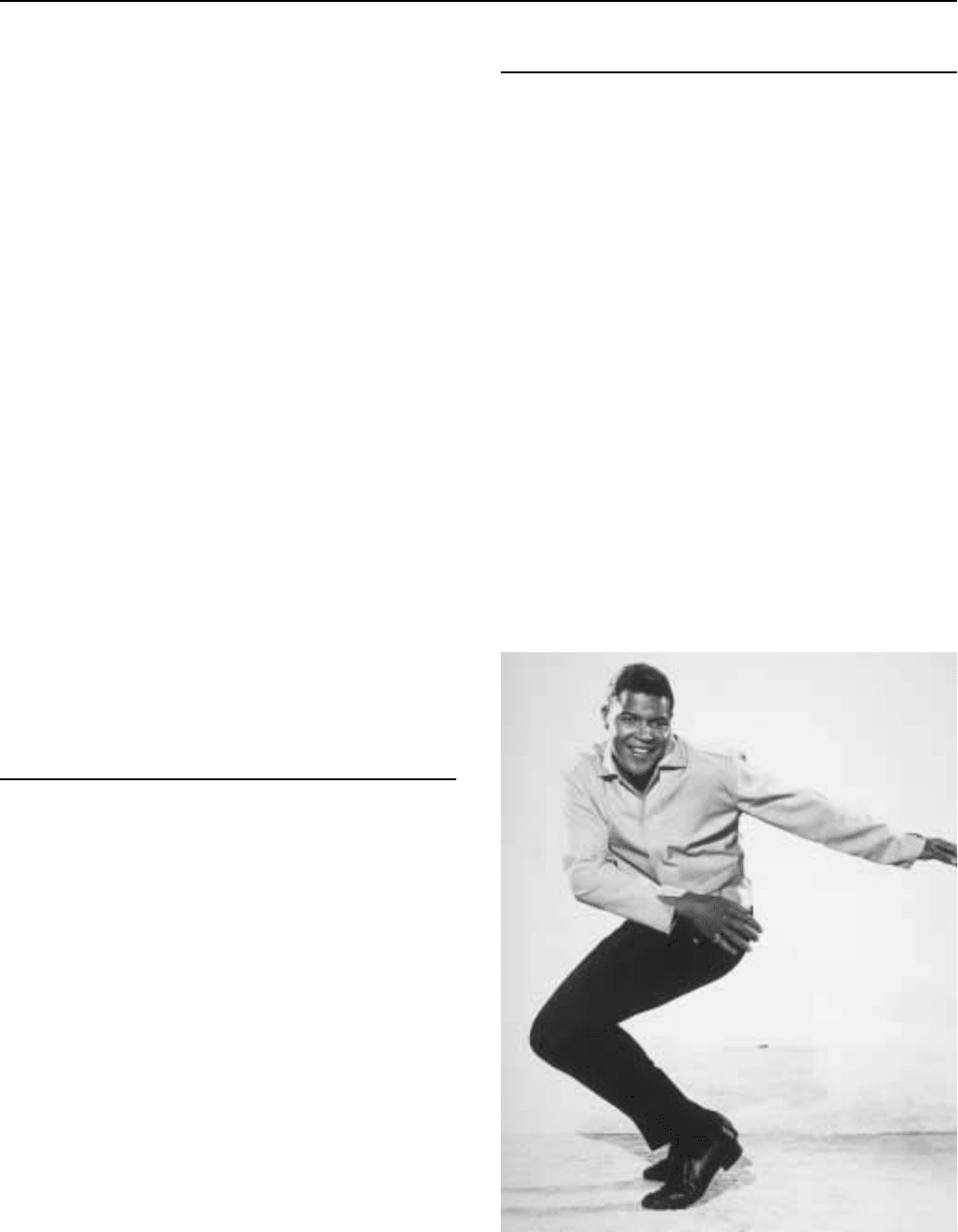
CHAYEFSKY ENCYCLOPEDIA OF POPULAR CULTURE
484
matter where he plays, Boozoo has never strayed from the recognition
that zydeco is first and foremost dance music. His songs include many
of the old French waltzes and two-steps from earlier times, but are
always spiced up a bit in his inimitable fashion. In a recently
published book, zydeco observer Michael Tisserand characterized
Boozoo’s playing as a ‘‘punchier, more percussive style.’’ Thematically,
Chavis stays close to home, writing songs about his family, friends,
farm, and beloved race horses that sport names such as ‘‘Camel’’ and
‘‘Motor Dude.’’
In the face of ever more urban and homogenizing influences on
zydeco, Boozoo Chavis remains rooted in the music’s rural traditions.
He is just as likely to be fixing up the barn or working with his horses
as playing at a dance or a concert. While a half-serious, half in jest
controversy has simmered over the years regarding who should
follow the reign of Clifton Chenier as the King of Zydeco, most
cognoscenti agree that of all the leading contenders for the crown,
Boozoo Chavis is most deserving of the accolade. He is the perennial
favorite at the Zydeco Festival in Plaisance, Louisiana, where he often
waits in the shade of the towering live oaks to greet his many fans and
sign autographs. His music, like the person that he is, is the real article.
—Robert Kuhlken
F
URTHER READING:
Broven, John. South to Louisiana: The Music of the Cajun Bayous.
Gretna, Louisiana, Pelican Publishing, 1983.
Nyhan, Patricia, et al. Let the Good Times Roll! A Guide to Cajun &
Zydeco Music. Portland, Maine, Upbeat Books, 1997.
Tisserand, Michael. The Kingdom of Zydeco. New York, Arcade
Publishing, 1998.
Chayefsky, Paddy (1923-1981)
Distinguished playwright, novelist, and screenwriter Paddy (born
Sidney) Chayefsky was a major force in the flowering of post-World
War II television drama, sympathetically chronicling the lives and
problems of ordinary people. His most famous piece of this period is
Marty, about the love affair between two homely people, which
became an Oscar-winning film in 1955. Bronx-born and college
educated, he attempted a career as a stand-up comic before military
service, and began writing when wounded out of the army. The most
acclaimed of his Broadway plays is The Tenth Man (1959), drawing
on Jewish mythology, but he found his wider audience through
Hollywood, notably with original screenplays for The Hospital (1971)
and Network (1976), both of which won him Academy Awards and
revealed that he had broadened his scope into angry satire. He
controversially withdrew his name from the 1980 film of his novel
Altered States (1978), which he had adapted himself, and died a
year later.
—Robyn Karney
F
URTHER READING:
Considine, Shaun. Mad as Hell: The Life and Work of Paddy
Chayefsky. New York, Random House, 1994.
Checker, Chubby (1941—)
One of several popular male vocalists to emerge from the
Philadelphia rock ’n’ roll scene in the late 1950s and early 1960s,
Chubby Checker was the chief beneficiary of the fervor created by the
dance known as the Twist.
Checker was born Ernest Evans on October 3, 1941 in Spring
Gully, South Carolina, the child of poor tobacco farmers. At the age of
nine he moved to Philadelphia and eventually began working at a
neighborhood produce market where he acquired his famous nick-
name ‘‘Chubby’’ from his employer. Evans’ big break, however,
came at age 16 while working at a local poultry market. Proprietor
Henry Colt overheard Evans singing a familiar tune as he went about
his work. Colt was impressed with Evans’ talent and referred him to a
songwriter friend named Cal Mann who was, at that time, working
with Dick Clark.
Dick Clark and his American Bandstand had a lot to do with the
popularity of many Philadelphian singers who frequently appeared on
the program. Frankie Avalon, Bobby Rydell, Fabian, and Checker
were among the teen idols who careers took off after they gained
exposure to millions of American teenagers via television. Checker
was one of very few black teen idols of that period, however. In his
case, even his stage name derived from contact with Dick Clark. Clark
and his wife were looking for someone to impersonate Fats Domino
for an upcoming album. Hoping to give Evans’ career a boost, Clark’s
wife is said to have dubbed the young performer ‘‘Chubby Checker’’
because the name sounded like Fats Domino.
Chubby Checker
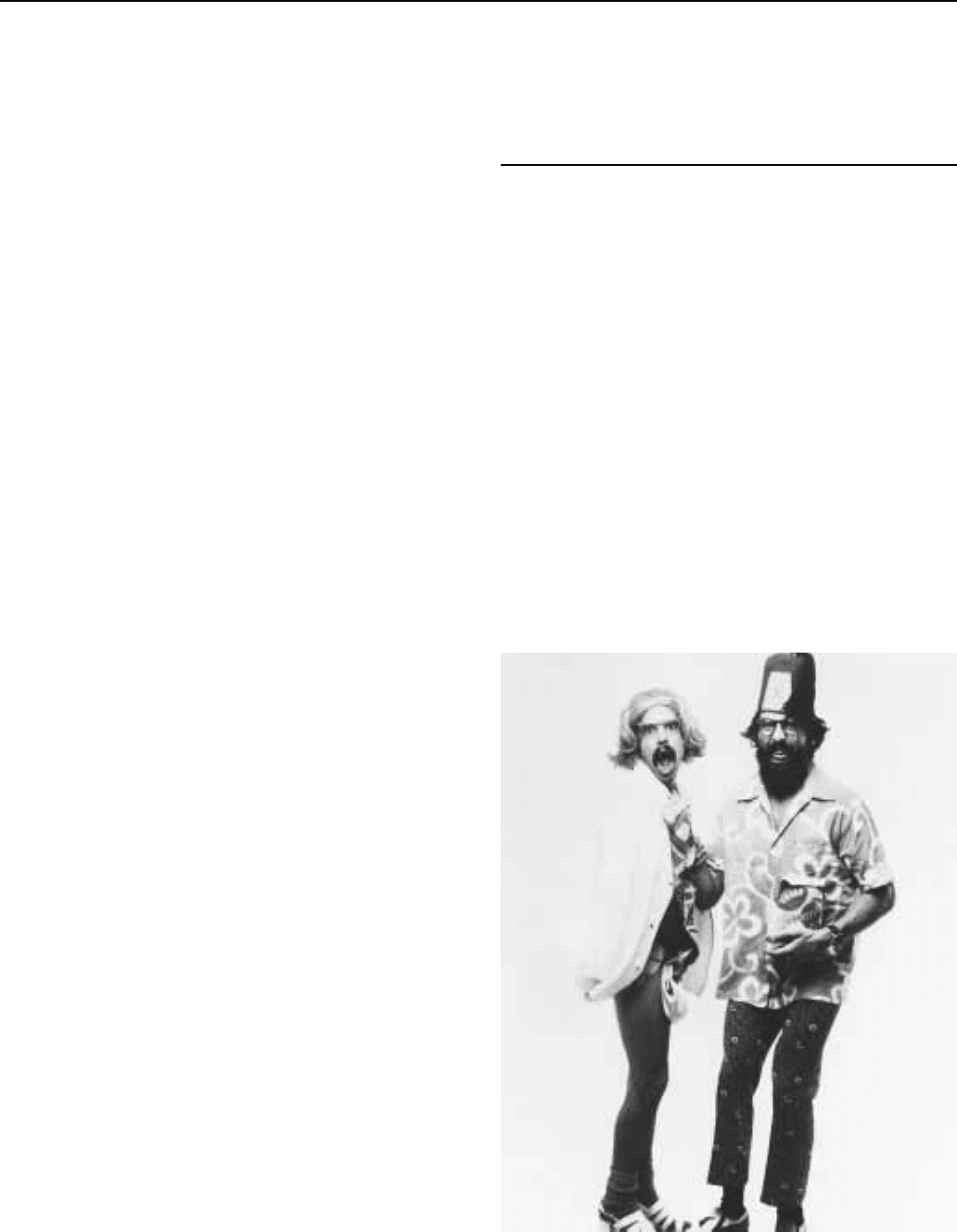
CHEECH AND CHONGENCYCLOPEDIA OF POPULAR CULTURE
485
The song entitled ‘‘The Twist’’ was originally released as the
flip side of a 45 rpm single by Hank Ballard and the Midnighters, a
popular R&B singing group. Checker released ‘‘The Twist’’ as an A-
side on the Parkway label in August 1960, aggressively promoting the
record and the dance in personal appearances and on television.
Numerous Chubby Checker performances on programs like the
Philadelphia-based American Bandstand helped fuel both the Twist
Craze and Checker’s career.
Chubby Checker’s recording of ‘‘The Twist’’ went to #1 on the
Billboard Top 40 charts in mid-September, 1960. Eager to capitalize
on the success of that record, Checker released several other Twist-
related singles such as ‘‘Let’s Twist Again,’’ ‘‘Twist It Up,’’ and
‘‘Slow Twistin’.’’ In fact, almost all of his records were dance tunes,
such as the #1 hit ‘‘Pony Time,’’ ‘‘The Hucklebuck,’’ ‘‘The Fly,’’
and the #2 hit ‘‘Limbo Rock.’’
Several films were produced in an attempt to cash in on the
popularity of the Twist, and Chubby Checker was the star of two of
them. Alan Freed’s Rock around the Clock and Don’t Knock the Rock
were the first rock ’n’ roll exploitation films ever made, back in 1956;
in 1961 Chubby Checker starred in Twist around the Clock and Don’t
Knock the Twist, remakes of the Freed films made after only five
years had passed. Checker also went on to appear in other movies
such as Teenage Millionaire.
Perhaps as a result of the Twist movies being released in the
second half of 1961, the Twist craze resurfaced and Checker’s version
of ‘‘The Twist’’ was re-released by Parkway. The record was even
more successful the second time around, and ‘‘The Twist’’ was the
first #1 record of 1962. This is the only case during the rock ’n’ roll era
of the same record earning #1 on the Top 40 on two different occasions.
Four months later, in May 1962, Chubby Checker was awarded a
Grammy for best rock and roll recording of 1961, ostensibly for
‘‘Let’s Twist Again.’’ The latter was a moderate (#8) hit in 1961, but
in no sense the best rock ’n’ roll song of the year. Checker’s
triumphant re-release of ‘‘The Twist’’ did set a new record, but that
achievement took place in 1962, and technically the song was not
eligible for a 1961 Grammy.
Chubby Checker continued to release singles and albums of rock
and roll, primarily dance music. Although he had a few more hits,
such as ‘‘Limbo Rock’’ in 1962, no subsequent dances were ever as
good to Checker as the Twist had been. By the end of 1965 he had
placed 22 songs on the Top 40, including seven Top Ten hits, but his
best period was over by the end of 1962.
Since the mid-1970s Checker has benefitted from another trend,
oldies nostalgia. Along with many other former teen idols, Checker
has seen a resurgence of his career at state fairs and on oldies tours,
playing the old songs again for a multi-generational audience.
—David Lonergan
F
URTHER READING:
‘‘Australian Fan Site of Chubby Checker.’’ http://www.ozemail.
com.au/~facerg/chubby.htm. February 1999.
Morrison, Tonya Parker. ‘‘Chubby Checker: ’The Wheel that Rock
Rolls On,’’’ American Press, 30 October 1998.
Nite, Norm N. Rock On Almanac. 2nd edition. New York,
HarperPerennial, 1992.
Stambler, Irwin. The Encyclopedia of Pop, Rock and Soul. Revised
edition. New York, St. Martin’s Press, 1989.
Whitburn, Joel. The Billboard Book of Top 40 Hits. 6th edition. New
York, Billboard Books, 1996.
Cheech and Chong
Cheech and Chong were a comedy team of the early 1970s that
opened for rock bands, recorded a series of popular comedy albums,
performed on the college circuit, and appeared in their own movies.
Their comedy routines consisted largely of ‘‘doper jokes,’’ reflecting
the drug culture and scatological humor of the 1960s. Richard
‘‘Cheech’’ Marin (1946—) and Tommy Chong (1938—) met in 1968
in Vancouver, British Columbia, where Cheech had fled to avoid the
U.S. draft during the Vietnam War. Together they co-founded an
improv group called City Works, and performed in a nightclub owned
by Chong’s brother. By 1970 they were known as Cheech and Chong,
and were performing in nightclubs in Toronto and Los Angeles.
Canadian-born Tommy Chong, half Chinese and half Scottish-
Irish, was playing the guitar in a band called Bobby Taylor and the
Vancouvers when he met Cheech, who started out singing with the
band. Cheech, born of Mexican parents in South Central Los Angeles,
grew up in Granada Hills, near the San Fernando Valley. The duo
recorded several successful comedy albums in the early 1970s. In
1971, Cheech and Chong was nominated for a Grammy for Best
Comedy Recording, and their 1972 album Big Bambu retained the
record of being the largest-selling comedy recording for many years.
Los Cochinos won the Grammy for Best Comedy Recording in 1973.
Cheech Marin (left) and Tommy Chong

CHEERLEADING ENCYCLOPEDIA OF POPULAR CULTURE
486
Their humor, although very vulgar at times, was entertaining, with
Cheech playing a jaunty marijuana smoking dopehead, and Chong
playing a burned out, laid back musician.
Their successful movies of the late 1970s and early 1980s
became doper cult classics. Up in Smoke was released in 1978,
Cheech & Chong’s Next Movie in 1980, and Cheech & Chong’s Nice
Dreams in 1981. In these three movies they play simple-minded pot
heads, or left over hippies, but their comic teamwork has been
compared to Laurel and Hardy. The screenplays were written by both
Cheech and Chong, with the directing done primarily by Chong. Their
last films together were Things Are Tough All Over (1982), in which
they both play dual roles; Still Smokin’ (1983); The Corsican Brothers
(1984), in which they go ‘‘straight’’; and Cheech and Chong Get
Out of My Room, directed by Cheech in 1985 for the cable
channel Showtime.
The pair split up in 1985, and from there Tommy Chong’s career
fizzled. He starred in the 1990 film Far Out Man, which bombed, and
he tried stand-up comedy in 1991 without much success. Cheech
Marin, on the other hand, went on to a successful career as a director
and actor in several films and television shows. His film Born in East
L.A. (1987) has become a classic among Mexican Americans and is
often included in academic classes of Chicano Studies. In the 1990s
he received small supporting roles in several films, including a well-
received part in the hit Tin Cup, starring Kevin Costner, and played
the television role of Joe Dominquez in Nash Bridges.
—Rafaela Castro
F
URTHER READING:
Chong, Thomas, and Cheech Marin. Cheech and Chong’s Next
Movie. New York, Jove Publicatons, 1980.
Goldberg, Robert. ‘‘From Drugs to Duels: Cheech and Chong Go
Straight’’. Wall Street Journal. July 24, 1984.
Menard, Valerie. ‘‘Cheech Enjoys Second Career in TV.’’ Hispanic.
Vol. 9, No. 9, 1998, 12-14.
Mills, David. ‘‘Tommy Chong: Reefer Sadness.’’ Washington Post.
June 15, 1991, C1.
Cheerleading
Few archetypes so exemplify every stereotype of women in
modern culture as that of the cheerleader. An uneasy juxtaposition of
clean-cut athlete, ultra-feminine bubble-headed socialite, skilled dancer,
and buxom slut, the cheerleader is at the same time admired and
ridiculed, lusted after and legitimized by everyone from junior high
school girls to male sports fans. Though cheerleading began as an all-
male domain, and there are still male cheerleaders, it is for girls that
the role of cheerleader is a rite of passage, whether to be coveted or
scorned. Public figures as widely diverse as Gloria Steinem, John
Connally, and Paula Abdul spent part of their early years urging the
crowd to cheer for their athletic team.
Cheerleading as we know it began in November 1898 at a
University of Minnesota football game, when an enthusiastic student
named Johnny Campbell jumped up to yell:
Rah, Rah, Rah
Sku-u-mah
Hoorah, hoorah
Varsity, varsity
Minn-e-so-ta!
The idea caught on, and in the early 1900s at Texas A&M,
freshmen, who were not allowed to bring dates to athletic events,
styled themselves as yell leaders, with special sweaters and mega-
phones. They became so popular, especially with women, that soon
the juniors and seniors took the role away from the freshmen.
Only men took on the highly visible role of cheerleading until
after World War II, when women began to form cheerleading squads,
wearing demure uniforms with skirts that fell well below the knee. In
the late 1940s, the president of Kilgore College in Texas had the idea
of creating an attractive female dancing and cheering squad as a tactic
to keep students from going to the parking lot to drink during half
time. He hired a choreographer, commissioned flashy costumes, and
the idea of cheerleading as a sort of sexy show-biz entertainment took
off. By the 1990s, there were over three million cheerleaders nation-
wide, almost all of them female.
Cheerleading means different things on the different levels it is
practiced. In junior high, high school, and college, cheerleading is
very much a social construct. Cheerleading tryouts appeal to girls for
many reasons. Some seek the prestige and social status afforded those
who make the cut. These chosen few are admired by the boys and
envied by the girls as they represent their school at games and hobnob
with the boys’ elite—the athletic teams. Those who are rejected after
tryouts often experience deep humiliation. Of course there are many
who reject the school status hierarchies and who view the cheerlead-
ers as shallow snobs rather than social successes. Another way to
view cheerleaders is as strong athletes who seek recognition in one of
the only areas acceptable for females. In fact, in many schools, prior
to the Title IX laws of the 1970s, there were no athletic teams for girls,
and cheerleading was the only outlet where girls could demonstrate
athletic skill.
Many supporters of cheerleading stress the athletic side of
cheerleading and the strength required to perform the jumps and
gymnastic feats that accompany cheers. There are local and national
cheerleading competitions, where squads compete and are judged on
creativity, execution, degree of difficulty, and overall performance.
Over the years, cheerleading has developed from simple gestures and
jumps to difficult gymnastic stunts and complex dance routines. As
the athletic skill required to become a cheerleader has increased, so
has the number of cheerleading-related injuries. In 1986, the reputa-
tion of cheerleading suffered when two cheerleaders in different
schools were involved in major accidents within a week. A young
woman was killed and a young man paralyzed while practicing their
cheerleading stunts. A Consumer Product Safety Commission study
in 1990 found 12,405 emergency room injuries that year were
related to cheerleading, prompting parental demands for greater
safety precautions.
Another sort of cheerleading is found in professional sports.
While fitting a standard mold of attractiveness is one of the primary
requisites of any sort of cheerleading, the professional squads have
taken it to extremes. Tryouts for squads like the Dallas Cowboy
Cheerleaders, the New Orleans Saints’ Saintsations, and the Buffalo
Bills’ Buffalo Jills, seem almost like auditions for a Broadway play,
with hundreds of flamboyantly made-up dancers and performers
competing for a few openings. The cheerleaders perform for exposure
and love of their team rather than money. In an industry where the
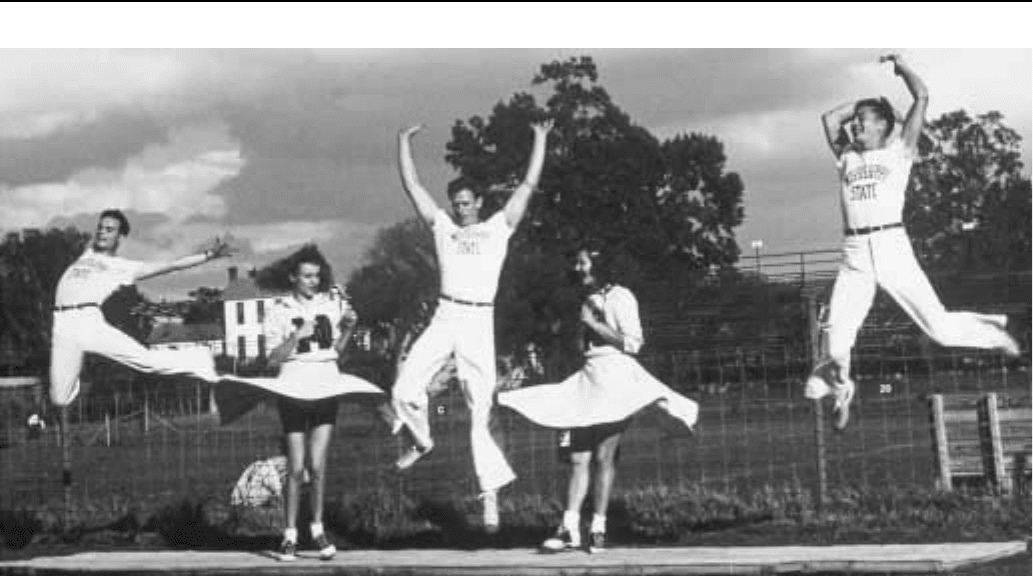
CHEERLEADINGENCYCLOPEDIA OF POPULAR CULTURE
487
A group of cheerleaders from Mississippi State University.
athletes might earn millions, most cheerleaders are paid only ten to
twenty-five dollars a game. Some are able to acquire contracts for
local advertising to supplement their income, and some hope to go on
to show business careers, but for many, just as in high school, it is the
admiration of the crowd and the identification with the team that is
the payoff.
It is in the professional arena that the risqué side of cheerleading
has received the most publicity. Because cheerleaders are almost
always chosen for standard good looks and shapely bodies in addition
to whatever skills may be required, even in high schools, rumors of
immorality circulate. In the professional squads, where outfits are
often skimpy and the routines flirtatious, the rumors are even more
graphic. Though most squads advertise a high moral standard, the
stereotype of the sexpot cheerleader has been hard to defeat. Movies
such as the XXX rated Debbie Does Dallas contribute to this, as did
the 1979 Playboy Magazine spread featuring nude photos of a
fictional cheerleading squad called the Texas Cowgirls.
Cheerleading has also grown into a big business. In the 1950s, a
former Texas high school cheerleader named James Herkimer (he
developed a cheerleading jump called the ‘‘herkie’’) founded the
National Cheerleader Association. The NCA is a for-profit enterprise
based in Dallas that runs hundreds of cheerleading camps nationwide,
teaching young aspiring cheerleaders jumping and cheering skills at a
reasonable rate. The cost of the camps is kept low, but the cheerleading
squads who attend the camps usually purchase their uniforms and
other accoutrements from the NCA-affiliated National Spirit group.
Since it costs about $200 to outfit the average cheerleader, 3 million
cheerleaders represent a sizable market, and by the 1990s, the NCA
was grossing over 60 million dollars a year.
The huge profits have attracted competition. In the 1970s, Jeff
Webb, a former protégé of James Herkimer, began his own company
in Memphis, the Universal Cheerleading Association, and its parent
company, the Varsity Spirit Corporation. While Herkimer has clung
to the classic cheerleading style, with athletic jumps and rhythmic
arm motions, Webb opted for a more modern approach; his camps
teach elaborate gymnastic stunts and dance routines, and his supply
company markets flashier uniforms and specialty items. Varsity
Spirit Corp. has even expanded abroad, signing a deal in Japan, where
cheerleading is very popular. Though NCA and UCA are the largest,
the expanding ‘‘school spirit industry’’ has prompted the creation of
many other cheerleading camp/supplier companies.
Because cheerleaders play such an important role in many
schools, cheerleading has become a battleground for social issues. In
1969 over half of the public school students in Crystal City, Texas,
staged a walkout for twenty-eight days in protest of their school’s
racist policies concerning cheerleader selection. In a district where 85
percent of the students were Chicano, it was not unusual for only one
Chicana cheerleader to be selected. The students’ action was success-
ful and it was the root of the Chicano movement organization, Raza
Unida. In 1993, four cheerleaders on a high school squad in Hempstead,
Texas, found they were pregnant. Only one was allowed to return to
cheering; she had an abortion, and she was white. The other students,
who were African American, fought the decision with the support of
the National Organization for Women and the American Civil Liber-
ties Union. They were finally reinstated. In 1991, another student
charged the University of Connecticut with discrimination when they
dropped her from the cheering squad for being, at 130 pounds, over
the weight limit. Her suit resulted not only in her reinstatement but in
the abolition of the weight requirement.
The fierce competition surrounding cheerleading has been docu-
mented in a cable-TV movie starring Holly Hunter in the title role of
The Positively True Adventures of the Alleged Texas Cheerleader-
Murdering Mom. The movie takes playful liberties with the true story
of Wanda Holloway, who plotted to have the mother of her daughter’s

CHEERS ENCYCLOPEDIA OF POPULAR CULTURE
488
cheerleading rival killed. Journalists in Texas, where cheerleading is
taken seriously, were surprised only by the fact that Holloway
presumed that the murder would prevent the rival from trying out for
the squad. The media is full of other such stories: the New Jersey
cheerleaders who in 1998 fed the opposing squad cupcakes filled with
laxatives, and the South Carolina cheerleaders who spiced up a
1995 Florida competition by holding their own private contest—
in shoplifting.
Cheerleaders are easy targets for satire, their raison d’être
construed as boosterism, and they are often stereotyped as being
stupid and superficial. In 1990, the University of Illinois was prompt-
ed to take the soft-core sexual image of cheerleaders seriously. Noting
the high rate of sexual assault on campus, a university task force
recommended banning the cheerleaders, the Illinettes, because the
all-female squad maintained a high-profile image as sexual objects. In
this light, it is easy to see that male cheerleading is a distinctly
different phenomenon; men in letter sweaters with megaphones
yelling and doing acrobatics clearly fill a different role than scantily-
clad women doing the same yells and acrobatics.
Debate continues over whether cheerleaders are athletes or
bimbos; whether cheerleading is, in itself, a sport, or an adjunct to the
real (mostly male) sports. Some women devote their lives to
cheerleading, for themselves or their daughters; some women con-
demn it because it turns women into boosters at best and sex objects at
worst. Some men delight in watching the dances of the flamboyant
squads at half-time; some men see them as a distraction to the game
and belive they should be abolished. And in junior high and high
schools across the country, girls, even many who profess not to care,
still train to perform difficult routines for tryouts and anxiously watch
bulletin boards to see if they made the squad.
—Tina Gianoulis
F
URTHER READING:
Hanson, Mary Ellen. Go! Fight! Win!: Cheerleading in American
Culture. Bowling Green, Ohio, Bowling Green State University
Popular Press, 1995.
Ralston, Jeannie. ‘‘Rah! Power.’’ Texas Monthly. Vol. 22, No. 10,
October, 1994, 150.
Scholz, Suzette, Stephanie Scholz, and Sheri Scholz. Deep in the
Heart of Texas: Reflections of Former Dallas Cowboy Cheerlead-
ers. New York, St. Martin’s Press, 1991.
Cheers
Cheers was the longest-running and most critically acclaimed
situation comedy on 1980s television. Combining physical and verbal
gags with equal dexterity, Cheers turned the denizens of a small
Boston bar into full-fledged American archetypes. By the end of the
show’s run, author Kurt Vonnegut, Jr., was moved to call Cheers the
‘‘one comic masterpiece’’ in TV history. The author of many comic
fiction classics added, ‘‘I wish I’d written [Cheers] instead of
everything I had written. Every time anybody opens his or her mouth
on that show, it’s significant. It’s funny.’’
Cheers was set at a Boston bar of the same name owned by Sam
Malone (Ted Danson), a good-looking former relief pitcher for the
woebegone Boston Red Sox whose career was cut short by a drinking
problem. His alcoholism under control, he reveled in his semi-
celebrity and status as a ladies’ man. Tending bar was Sam’s old Red
Sox coach, the befuddled Ernie Pantuso (Nicholas Colasanto), a
character obviously modeled on baseball great Yogi Berra. In early
1985, Colasanto suddenly died. He was replaced behind the bar by an
ignorant Indiana farm boy, Woody Boyd (Woody Harrelson). Carla
Tortelli (Rhea Perlman) was the foul-mouthed waitress; a single
mother, she bore several children out of wedlock during the show’s
eleven-year run. To one woman she threatened, ‘‘You sound like a
lady who’s getting tired of her teeth.’’ The bar’s regulars were the
pathetic Norm Peterson (George Wendt), a perpetually unemployed
accountant trapped in a loveless marriage to the unseen Vera; and
the equally pathetic Cliff Clavin (John Ratzenberger), the resident
trivia expert and career postal worker, who still lived with his
domineering mother.
In the series’ first episode Diane Chambers (Shelley Long), a
pretentious, well-to-do graduate student, was abandoned at the bar by
her fiancé en route to their wedding. Sam offered her a job waitressing,
thus beginning one of the most complex romances in prime time TV
history. Sam and Diane swapped insults for most of the first season,
and a volley of insults on the season’s last episode culminated in their
first kiss. They consummated their relationship in the first episode of
the second season:
SAM: You’ve made my life a living hell.
DIANE: I didn’t want you to think I was easy.
Yet Sam and Diane never tied the knot. Diane left Sam and
received psychiatric help from Dr. Frasier Crane (Kelsey Grammer),
with whom she promptly fell in love. Diane and Frasier planned a
European wedding, but she left him at the altar. By the 1986-87
season Sam and Diane were engaged when, on the eve of their
wedding, Diane won a sizable deal to write her first novel. Sam
allowed her to leave for six months to write, knowing it would
be forever.
Sam sold the bar to go on a round-the-world trip. He humbly
returned to become the bartender for the bar’s new manager, Rebecca
Howe (Kirstie Alley), a cold corporate type. The bar was now owned
by a slick British yuppie, Robin Colcord, who had designs on
Rebecca. When Robin was arrested for insider trading, Sam was able
to buy back the bar for a dollar.
Life went on for the Cheers regulars. Dumped by Diane, the
cerebral Frasier grew darker and more sarcastic, barely surviving a
marriage to an anal-retentive, humorless colleague, Lilith (Bebe
Neuwirth). Sam and Rebecca enjoyed a whirlwind romance and
contemplated having a baby together out of wedlock. Carla married a
professional hockey player, who was killed when a Zamboni ran over
him. Woody fell in love with a naive heiress, and by the final season
won a seat on the Boston City Council. Norm and Cliff remained
loyal customers, serving as Greek chorus to the increasingly
bizarre happenings.
Despite the wistful theme song (‘‘Sometimes you want to go /
Where everybody knows your name’’), the characters were frequent-
ly cruel to one another. Norm once stood up for the unpopular Cliff
this way: ‘‘In his defense, he’ll probably never reproduce.’’ During
one exchange Carla asked Diane, ‘‘Did your Living Bra die of
boredom?’’ They also engaged in elaborate practical jokes; Sam
